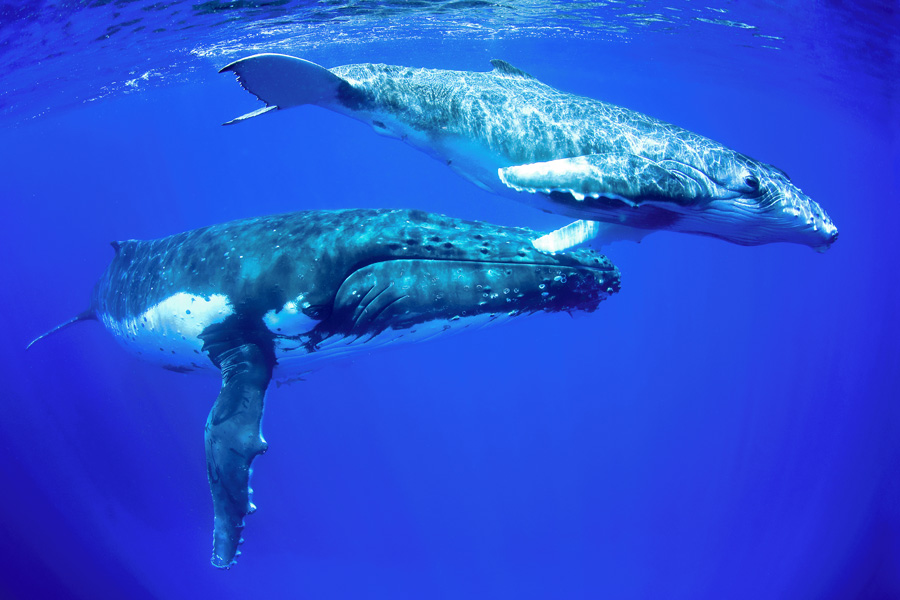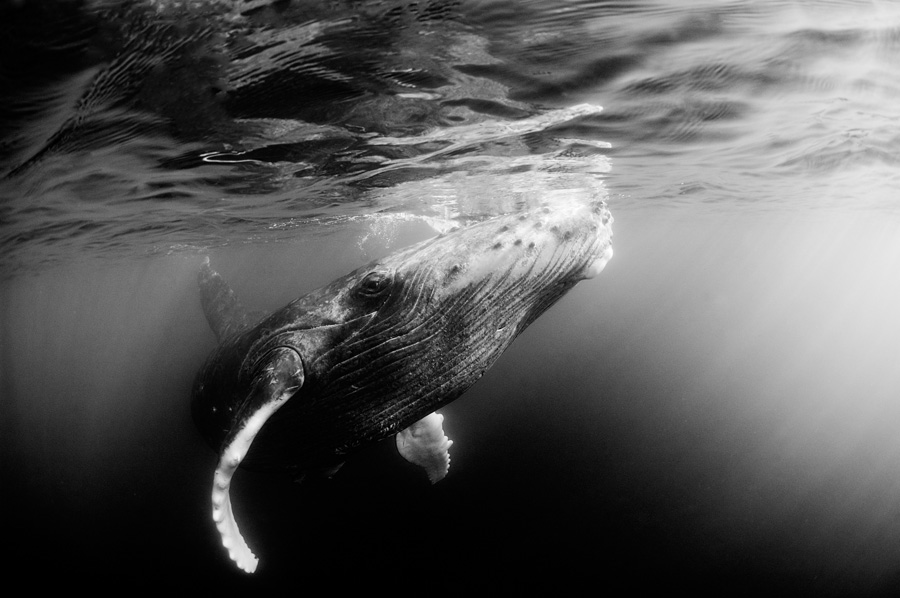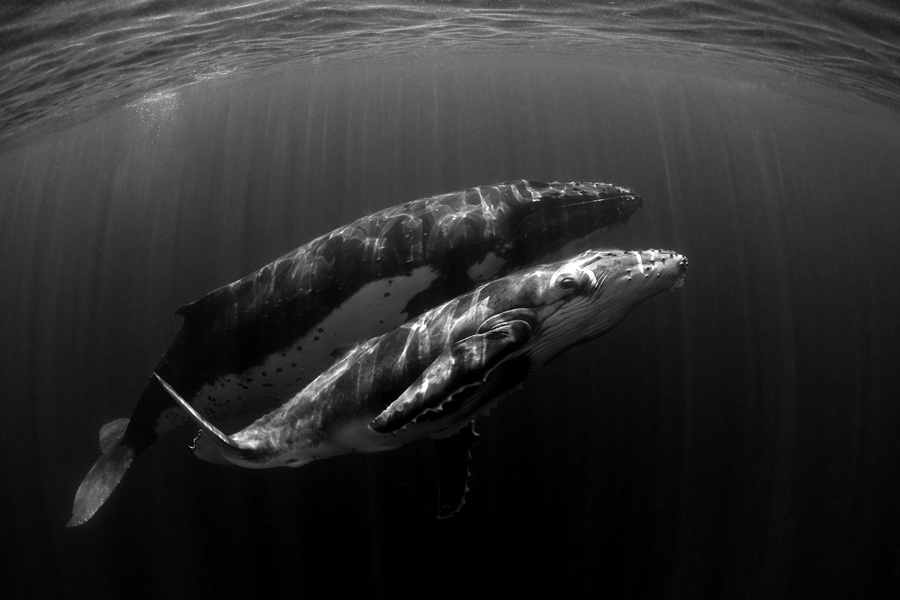A few weeks ago, I was able to see Douglas Hoffman hold a Q&A seminar on whale photography at Montage Kapalua Bay in Maui. On the walls were some of his most famous pieces; images of humpback whales bonding, dancing, and even flying through the air. I asked Douglas if he would sit down with me for an interview about his experience with the underwater world and he kindly obliged.
Story by James Hoot, Images provided by Douglas Hoffman
Douglas Hoffman creates portraits of landscapes, nature, and marine life that evoke emotional response. Beautiful composition and storytelling are ever-present in his work. Hoffman’s portraits of nature and marine life have received more than 40 international awards, been featured in art galleries, blogs, books, magazines, and museums. He earned his Master of Photography degree from Professional Photographers of America in 2012, utilizing only images of underwater photography.
While well known for black and white photographs, many of Douglas’ images are in color. Douglas says we live in a world of color, and experience it every day. People understand it, and identify with it based on their past life experience. However when people look at a black and white portrait they tend to pause in order to take in all the shades of grey and subtle tone differences. As a result they tap into the emotional side of their brain and really feel the image. Hoffman prints his work on aluminum, which many people refer to as high definition art. The reason is this medium has more luminosity than other mediums.
Q. How did you get your start into whale photography?
A. So, I’m no longer an insured scuba instructor, but back in 1989, I was. I dived Molokini crater in Maui every day. After years and years of diving, I finally had a whale come up to me on the back wall of Molokini during a safety stop. This was a magical moment, and it changed everything. Once that whale looked me in the eye, I was addicted and had to figure out how to swim with whales legally. I did some research and found the Dominican Public and Tonga had legal whale swimming programs. Being that visibility in Tonga was better and being from Hawaii, I selected Tonga.
My first trip to there was in 2006. I chartered a sailboat and did the whole Tonga chain consisting of three island groups. We had only 2 or 3 really good encounters that trip due to horrible weather.
Upon returning to Hawaii, I organized a trip for the next year. This pattern has repeated itself each year and 2016 will be my 10th year organizing trips to Tonga to swim with whales. Over that time I’ve learned a lot because the whale swim industry is like the dive industry. There are good dive operators, great dive operators, and mediocre operators. I think I had to go through all of them in my learning curve to figure out how I could get the best mutual interactions with whales and not just pay someone to take me out.
That image there, “Hope” was created and won the gold medal in 1998, “Our World Underwater Competition”.
Whales are wild animals. Just because you have a permit and it’s legal doesn’t mean that it’s easy.
It takes an incredible amount of intuition and knowledge on the part of the captain, the whale swim guide to determine if the whales being observed might be open to a mutual interaction. For the first six years of going to Tonga I was the whale swim guide. Several years ago the powers that be in Tonga implemented a new rule that all guides must go through a 3 week whale swim course. This was designed for several reasons: to establish a standard of behavior, make sure whale swim guides could swim effectively rescue people if necessary, and provide work opportunities for local Tongans.
At first I did not like the rule as it changed the dynamics of leading trips. The rules stated that there could be four people in the water plus a guide. But after working with this system I liked it as it made my job easier. The guide kept his eye on the whales and this allowed me to help the swimmers into the best position to observe and photograph the whales.
I am not looking to swim with every whale I see, but a lot of operators have that mindset. This is because there are two types of whale swim charters, public and private. A public or open charter boat takes 8 – 20 people. The law says only 4 people can be in the water with a the whales at a time, so they rotate groups in and out of the water. The captain’s mindset is to put as many people in the water with as many whales as he can. He doesn’t really care about the quality of the interaction, more about the quantity. I learned that the hard way. I get it though, these captains have a responsibility to show tourists whales. I want to see behavior. I want to observe them, so my need are different.
I started private chartering my boats and working with the captains to find only interactions that were going to be mutual. This means the whales are as interested in seeing us as we are to observe them. We spend a lot of time watching for the right behavior. When we find it we get in the water and observe the whales. If it’s all good, it could last for hours. I have had several 5, 6, & 7 hour swims.
Most Captains don’t really understand what photographers need in terms of finding the best visibility possible and always approaching the whale from the sunny side. Their job is to drive the boat and find whales. That said as photographers we need the cleanest water possible and that sometimes means traveling far. I don’t care about gas consumption, I care about clean water. I also want to approach whales from the sunny side so we have the light with us rather than against us.
So what caused my addiction? It was the emotional response I had when the whale looked me in the eye. I become part of something bigger than myself. I became an advocate and an ambassador for whales as to me they represent all life in the ocean. It’s about love and it’s about life, education and conservation. I am happy to say that my images have been used in numerous campaigns by NPO’s to educate the citizens of our world. It’s an honor to be able to contribute to these worthy causes.
Q. Are whales your favorite subjects to photograph?
A. Wow. Whales are definitely up there on my top list for sure. It’s a really hard question. I love photography of all kinds. Capturing the relationship of a family is priceless. Landscape photography is also something I love to do. But I would be remiss if I didn’t mention my passion for photographing coral reefs, soft coral, turtles, frog fish, and sharks. Being able to make a beautiful portrait underwater and share that with people that can’t go diving is an amazing feeling.”
Q. Can you tell us a bit about your favorite dive with a whale?
A.. Man there’s so many stories. I can tell you the most emotional one. This was the last day of a trip in 2008. There were just two of us on the boat. We’re heading in and we get a call on the radio, “There’s a woman and her child from New Zealand. The woman doesn’t know how to swim, but it’s been her life long dream to see a whale in the water. Will you assist them?” So we turned our boat around and picked up this mother and daughter and headed back to the whales that I had been working with that day. I left my camera in the boat, which is so unlike me. I helped this woman live her dream. I put her in a life preserver. I held on to her and her daughter and I swam them to where we could see the whales and we hovered. The whales came within 10 feet of us. The woman was so nervous she couldn’t stick her head in the water. I told her “all you have to do now to live your dream is stick your head in the water. That’s all. I’ve got your hand.” She gripped me like a vice grip, stuck her head in the water, and screamed “Oh my God”. She had a minute long experience with the whales and that was enough. She was shaking, trembling and not in control of her reality, so to speak. I towed her and her daughter back into the boat and received a nice kiss on the cheek. I felt like that was a pretty cool experience, helping someone live their dream.”
Q. Do you have any recommendations for people that want to make a living from diving or photography?
A. I wouldn’t recommend anyone try to make a living in stock photography. I would tell anyone who wants to have this kind of lifestyle, “Do it for the adventure and the fun, don’t do it for money.” There’s a lot of ways that you can travel for low cost or free and write for magazines and offer your services for trade at resorts and destinations. Be careful because you have to produce what you say you will. You don’t want to get a bad reputation.
It’s not a way to get rich, but it is a way to get out there. I’ve done that. I’ve got 12,000 dives and I’ve been all over and that’s how I did it. Early in my career I was writing for dive magazines. I didn’t get paid well, but I got recognition and free travel and gear which was nice. I don’t know anyone who really makes really good money as an underwater photographer anymore. The stock photography market is gone and magazines don’t pay a lot although getting published is great for the ego and resume. Creating beautiful photography to sell in galleries and exhibitions is hard, but selling art is harder. Beautiful images look great but don’t fly off the walls, people have to buy it. It’s probably one of the hardest ways to make a living.
So the long answer to the question is to become a professional diver and at least get paid for your diving. Work as an instructor on a live-aboard and travel around the world for a couple of years. Maybe good things will happen and doors will open.
Q. Of the photos sitting in front of us, which is your favorite and why?
A. “Mother’s Love”. Mother’s love…I look at that and I feel a connection. The emotion behind the image and the way that the angle of the mother and the calf together… it shows a connection, shows devotion, shows love, shows all that is right above and below the sea.
Q. Do you have any advice for divers trying to get into underwater photography? What kind of gear has worked best for you, etc?
A. This is the greatest question of all time. In order to be a great marine photographer, you’ve got to be a damn good diver and a master of your buoyancy. If you want to photograph an animal, you’ve got to know where they live, if it’s nocturnal, what it eats, and what it’s predators are. When you’re diving on the reef and you see those areas, you know that the animal is there. Mastering your buoyancy means you don’t break sponges, or coral, or worse screw up the visibility.
As far as equipment, Ikelite makes a very affordable housing that’s a great way to start. After you’ve been down that road, I would say an aluminum housing is the best way to go. These are expensive, as are optical glass ports. I’ve had 8 Nexus housings over my career and haven’t experienced any problems. Nauticam and Sea and sea are also very popular.
• • •
You can view Douglas’ work at www.DouglasJHoffman.com. He also has space available for 2015 whale observation trips. You can view these by going to his website and clicking on “Trips”.
Story by James Hoot, Images by Douglas Hoffman



